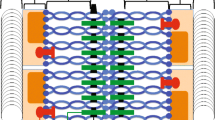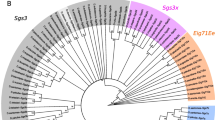Abstract
The Drosophila serendipity (sry) β and δ genes, which resulted from a gene duplication event, provide an interesting model for the evolutionary diversification in structure and function of C2H2 zinc finger proteins. We examined here the divergence of the sry β and δ proteins over an estimated period of 45 million years by comparing their predicted sequences in D. melanogaster, D. pseudoobscura, and D. subobscura. Between orthologs, i.e., pairs of either sry β or sry δ, the NH2-proximal region delineated by pairs of C-X2-C motifs and the DNA-binding finger domain are highly conserved. Sequence conservation operates over the entire finger domain, including the links separating adjacent fingers, even though each has a unique sequence different from the widespread TGEKP motif. In contrast, the sequence of the central acidic region has extensively diverged and differs between species in the number of amino acids, probably because of slippagedriven mutations. The NH2-terminal region and fingers 1, 5, and 6 differentiate the sry β and δ proteins while zinc fingers 2, 3, and 4 are virtually identical in these two paralogs. A nuclear localization signal of the SV40T antigen type, preceded by a potential CKII phosphorylation regulatory site, is conserved in sry δ but not found in sry β. The interspecific conserved regions correlate well with the positions of zygotic lethal mutations in the D. melanogaster sry δ protein. Furthermore, P-element transformation experiments show that a transgenic copy of the D. pseudoobscura sry δ gene rescues the sry δ mutant phenotype. Convergence of genetic and structural data on the sry proteins supports a multimodular function and mode of evolution of these C2H2 finger proteins.
Similar content being viewed by others
Abbreviations
- CKII:
-
casein kinase II
- D.m, D.p, D.s :
-
Drosophila melanogaster, D. pseudoobscura and D. subobscura, respectively
- NLS:
-
nuclear localization signal
- sry :
-
serendipity
References
Aguadé M (1988) Nucleotide sequence comparison of the rp49 gene region between Drosophila subobscura and D. melanogaster. Mol Biol Evol 5:433–441
Beverley SM, Wilson AC (1984) Molecular evolution in Drosophila and the higher diptera. II. A time scale for fly evolution. J Mol Evol 21:1–13
Brady JP, Richmond RC, Oakeshott JG (1990) Cloning of the esterase-5 locus from Drosophila pseudoobscura and comparison with its homologue in D. melanogaster. Mol Biol Evol 7:525–546
Colot HV, Hall JC, Rosbash M (1988) Interspecific comparison of the period gene of Drosophila reveals large blocks of nonconserved coding DNA. EMBO J 7:3929–3937
Crozatier M, Kongsuwan K, Ferrer P, Merriam JR, Lengyel JA, Vincent A (1992) Single amino-acid exchanges in separate domains of the Drosophila serendipity δ zinc finger proteins cause embryonic and sex biased lethality. Genetics 131:905–916
Dingwall C, Laskey RA (1991) Nuclear targeting sequences-a consensus? Trends Biochem Sci 16:478–481
Dover GA (1992) Observing development through evolutionary eyes: a practical approach. BioEssays 14:281–287
El Baradi T, Pieler T (1992) Zinc finger proteins: what we know and what we would like to know. Mech Dev 37:57–68
Henikoff S (1987) Unidirectional digestion with exonuclease III in DNA sequence analysis. Methods Enzymol 155:156–165
Hsu T, Gogos JA, Kirsh SA, Kafatos FC (1992) Multiple zinc finger forms resulting from developmentally alternative splicing of a transcription factor gene. Science 257:1946–1950
Klug A, Rhodes D (1987) “Zinc fingers”: a novel protein motif for nucleic acid recognition. Trends Biochem Sci 12:464–469
Liao X, Clemens KR, Tennant L, Wright PE, Gottesfeld JM (1992) Specific interaction of the first three zinc fingers of TFIIIA with the internal control region of the Xenopus 5S RNA gene. J Mol Biol 223:857–871
Miller J, Mc Lachlan AD, Klug A (1985) Repetitive zinc-binding domains in the protein transcription factor IIIA from Xenopus oocytes. EMBO J 4:1609–1614
Mismer D. Rubin GM (1987) Analysis of the nina E opsin gene in Drosophila melanogaster. Genetics 116:565–578
Mitchell PJ, Tjian R (1989) Transcriptional regulation in mammalian cells by sequence-specific DNA binding proteins. Science 245:371–378
Moses K, Ellis MC, Rubin GM (1989) The glass gene encodes a zinc-finger protein required by Drosophila photoreceptor cells. Nature 340:531–536
Nardelli J, Gibson TJ, Vesque C, Charnay P (1991) Sequence specific 1H NMR resonance assignments and secondary structure identification for 1 and 2 zinc finger constructs from SW 15: a hydrophobic core involving four invariant residues. Nature 349: 175–178
Neuhaus D, Nakaseko Y, Nagai K, Klug A (1990) Base sequence discrimination by zinc finger DNA-binding domains. FEBS Lett 262:179–184
Noselli S, Payre F, Vincent A (1992) Zinc fingers and other domains cooperate in binding of the Drosophila sry β and δ proteins at specific chromosomal sites. Mol Cell Biol 12:724–733
Noselli S, Vincent A (1991) A Drosophila nuclear localization signal included in an 18 amino-acid fragment from the serendipity δ zinc finger protein. FEBS Lett 280:167–170
Ohkuma Y, Sumimoto H, Hoffmann A, Shimasaki S, Horikoshi M, Roeder RG (1991) Structural motifs and potential σ homologies in the large subunit of human general transcription factor TFIIE. Nature 354:398–401
Pavletich NP, Pabo CO (1991) Zinc finger DNA recognition: Crystal structure of a Zif268-DNA complex at 2.1Å. Science 252:809–817
Payre F, Noselli S, Lefrère V, Vincent A (1990) The closely related Drosophila sry β and sry δ zinc finger proteins show differential embryonic expression and distinct patterns of binding sites on polytene chromosomes. Development 110:141–149
Payre F, Vincent A (1988) Finger proteins and DNA-specific recognition: distinct patterns of conserved amino-acids suggest different evolutionary modes. FEBS Lett 234:245–250
Payre F, Vincent A (1991) Genomic targets of the serendipity β and δ zinc finger proteins and their respective DNA recognition sites. EMBO J 10:2533–2541
Ptashne M (1988) How eukaryotic transcriptional activators work. Nature 335:683–689
Rihs H-P, Jans DA, Fan H, Peters R (1991) The rate of nuclear cytoplasmic protein transport is determined by the casein kinase II site flanking the nuclear localization sequence of the SV40 T-antigen. EMBO J 10:633–639
Rubin G, Spradling A (1982) Genetic transformation of Drosophila with transposable element vectors. Science 218:348–353
Sambrook J, Fritsch EF, Maniatis T (1989) Molecular cloning: a laboratory manual, 2nd ed. Cold Spring Harbor Laboratory Press, Cold Spring Harbor, NY
Segarra C, Aguadé M (1993) Nucleotide divergence of the rp 49 gene region between D. melanogaster and two species of the obscura group of Drosophila. J Mol Evol 36:243–248
Schuh R, Aicher W, Gaul U, Cote S, Preiss A, Maier D, Seifert E, Nauber U, Schroder C, Kemler R, Jaeckle H (1986) A conserved family of nuclear proteins containing structural elements of the finger protein encoded by Krüppel, a Drosophila segmentation gene. Cell 47:1025–1032
Tautz D, Trick M, Dover GA (1986) Cryptic simplicity in DNA is a major source of genetic variation. Nature 322:652–656
Vincent A, Colot HV, Rosbash M (1985) Sequence and structure of the serendipity locus of Drosophila melanogaster. A densely transcribed region including a blastoderm specific gene. J Mol Biol 186:149–166
Vrana KE, Churchill MEA, Tullius TD, Brown DD (1988) Mapping functional regions of transcription factor TFIIIA. Mol Cell Biol 8:1684–1696
Wheeler DA, Kyriacou CP, Greenacre ML, Rutila JE, Rosbash M, Hall JC (1991) Molecular transfer of a species-specific behaviour from D. simulans to D. melanogaster. Science 251:1082–1085
Yanicostas C, Vincent A, Lepesant JA (1989) Transcriptional and posttranscriptional regulation contributes to the sex-regulated expression of two sequence-related genes at the janus locus of Drosophila melanogaster. Mol Cell Biol 9:2526–2535
Zhu Q, Smith TF, Lathrop RH, Figge J (1990) Acid helix-turn activator motif. Proteins 8:156–163
Author information
Authors and Affiliations
Additional information
Correspondence to: A. Vincent
Rights and permissions
About this article
Cite this article
Ferrer, P., Crozatier, M., Salles, C. et al. Interspecific comparison of Drosophila serendipity δ and β: Multimodular structure of these C2H2 zinc finger proteins. J Mol Evol 38, 263–273 (1994). https://doi.org/10.1007/BF00176088
Received:
Accepted:
Issue Date:
DOI: https://doi.org/10.1007/BF00176088




